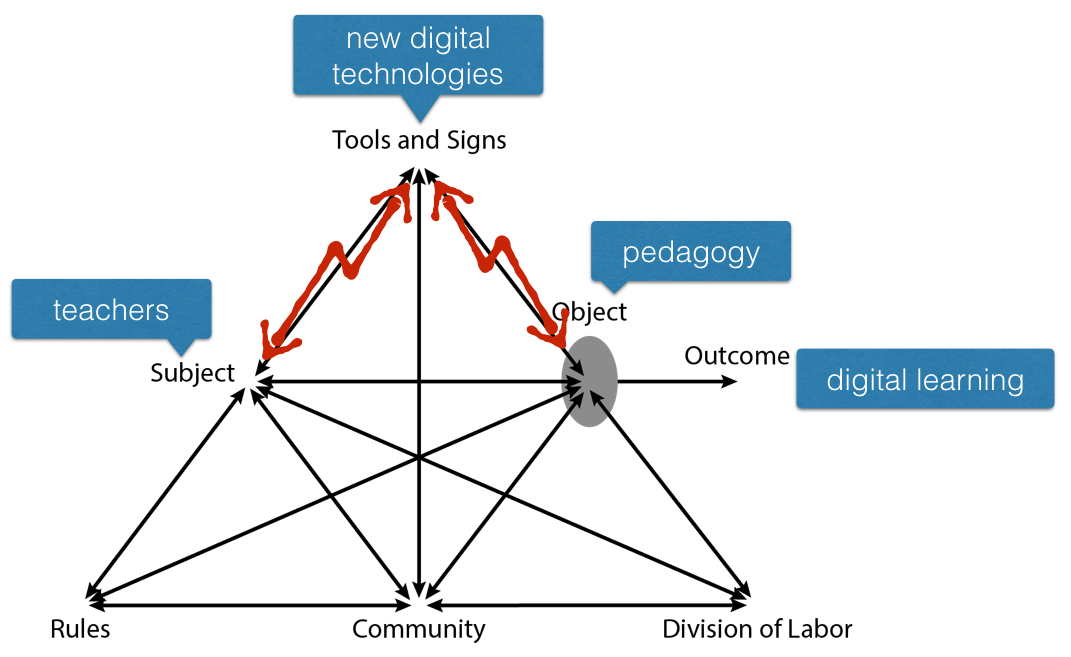
Much of the literature about the extrinic and intrinsic influences when integrating digital technologies in learning and teaching are based on early-stage deployments. The influences are shaped by the context (new technologies and changed institutional factors) and inexperience, leading to a specific set of contradictions and dilemmas for teachers. There are very few studies of the influences in schools with well-established, ubiquitous technology environments (UTE). As a result, the nature of the influences, contradictions and dilemma in these environments is not as well understood. This document provides an overview of the findings of a case study into the extrinsic influences and associated contradictions for teachers in a well-established UTE school (Blundell, Lee, & Nykvist, 2016).
The following table summarises teacher-reported extrinsic influences on practice and associated contradictions in a school with a well-established, ubiquitous technology environment. All students and teachers in the school had an iPad that was supported by extensive infrastructure, a dedicated IT support team including an 'e-earning coach', and high-speed access to cloud-based solutions. These data are based on two semi-structured interviews with eight participants and collaborative professional learning meetings.
| Category of Extrinsic Influence (frequency in brackets) | Specific Extrinsic Influences (frequency in brackets when described by more than one teacher) |
|---|---|
| Time for teacher engagement (12) | Learn (3) and relearn technology (2) Plan, develop ideas and resources (2) Finding the right tool / app To be creative / focus Update resources when technology changes Work / life balance |
| Working with colleagues (10) | ‘Traditional’ ideas and preparedness to change (3) Expectations (2) Attitudes Impact of inconsistency in content and pedagogical knowledge Limited experience of innovation by colleagues means feedback and support is unavailable Perception that teachers in a common subject need to teach the same way Willingness to collaborate |
| Curriculum and assessment, including time in class to cover material (7) | Less flexibility in higher year levels (2) |
| Expectations / perceptions / atti- tudes of students and/or parents (4) | Negative student attitudes about iPads Poor response to student-centric pedagogies Parent perceptions |
| Organisational (4) | Culture drives expectations to improve resources General expectations / climate Teacher allocated to different subjects in subsequent years, unable to leverage previous effort nor improve on prior work Money for different set-ups to make practice more efficient |
| Technology (2) | iPads Limitations of Learning Management System compared to other tools |
| Other (4) | Assessment modes prevent digital technologies integration Keeping up with students’ changing uses of digital technologies Demands of other roles / work Professional development in use of specific tools |
Activity Theory (Engeström, 2009) is a useful tool for identify so-called contradictions - the challenges faced by people in a system of activity; in this case, the challenges faced by the teachers in a well-established UTE school. Although contradictions (drawn as red arrows on each diagram) are challenging, they are also opportunities to engage in expansive learning.
Teacher-identified contradictions relating to time

Contradictions associated with time related to learning new technologies (or when the technology changed, e.g. software updates) and the time needed to create digital pedagogies.
Teacher-identified contradictions relating to existing paradigms
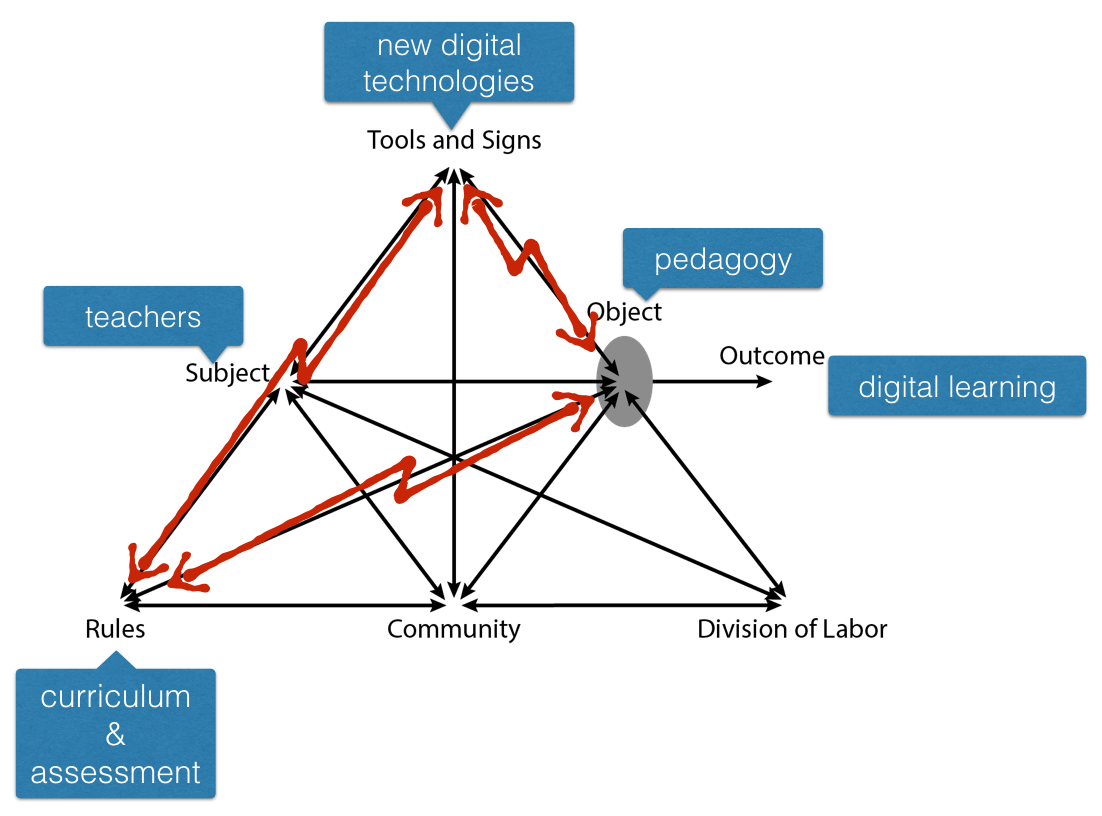
Technology disrupted established paradigms for efficiently covering curriculum and conducting assessment. This included the implications of new approaches to learning, teaching and assessment. In some instances, previously reliable (non-technology-based) approaches did not work as well, and in other instances, systemic requirements for curriculum and assessment constrained opportunities to use digital technology.
Teacher-identified contradictions relating to perceptions and expectations
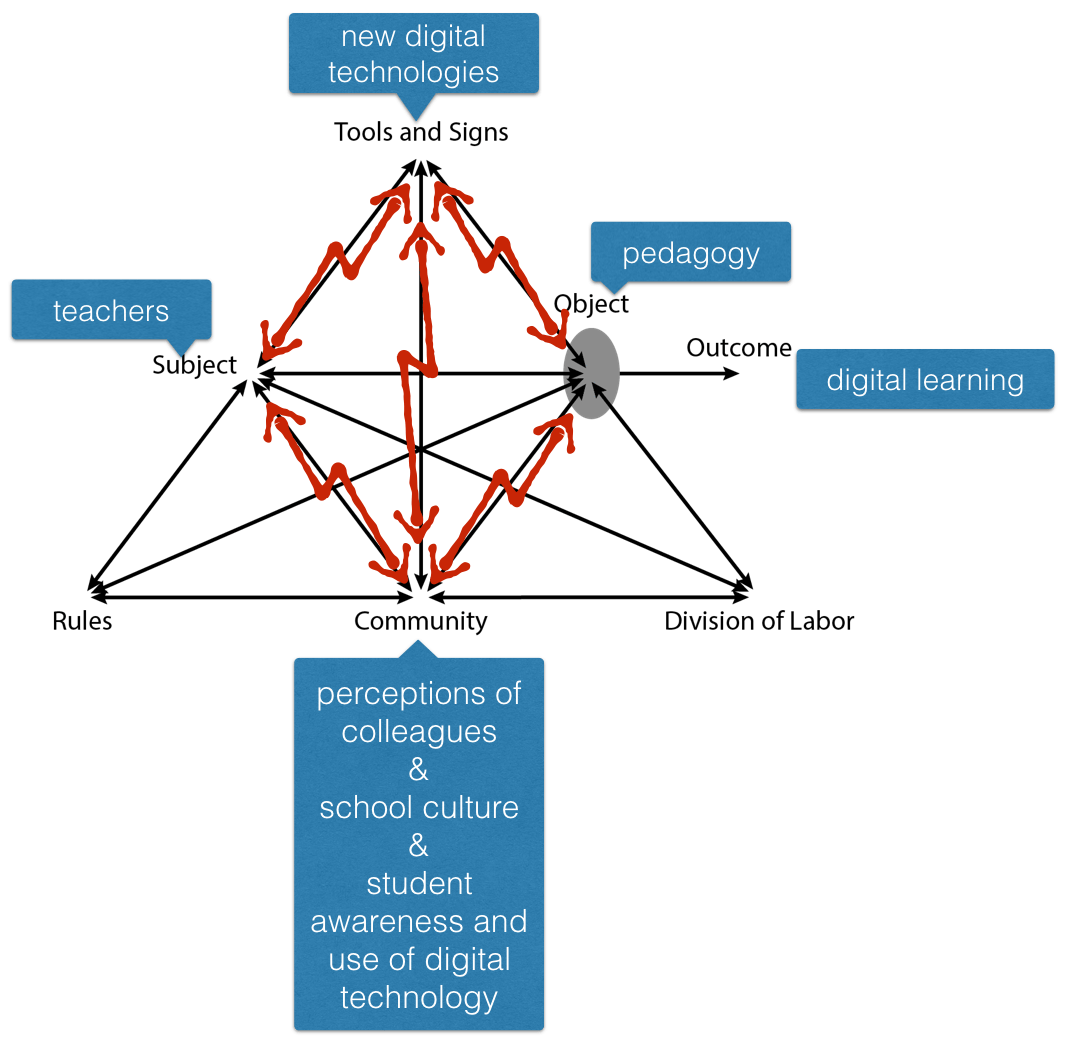
When considering using digital technologies to innovate, the perceptions of colleagues (positive or negative), the school culture (positive) and staying up-to-date with students' use of technology (positive or negative) created contradictions. In some instances negative perceptions constrained teachers' willingness to innovate; in other instances, positive perceptions created an expectation to innovate was greater than teachers' willingness or self-assessed capacity to change.
Teacher-identified contradictions relating to collaboration
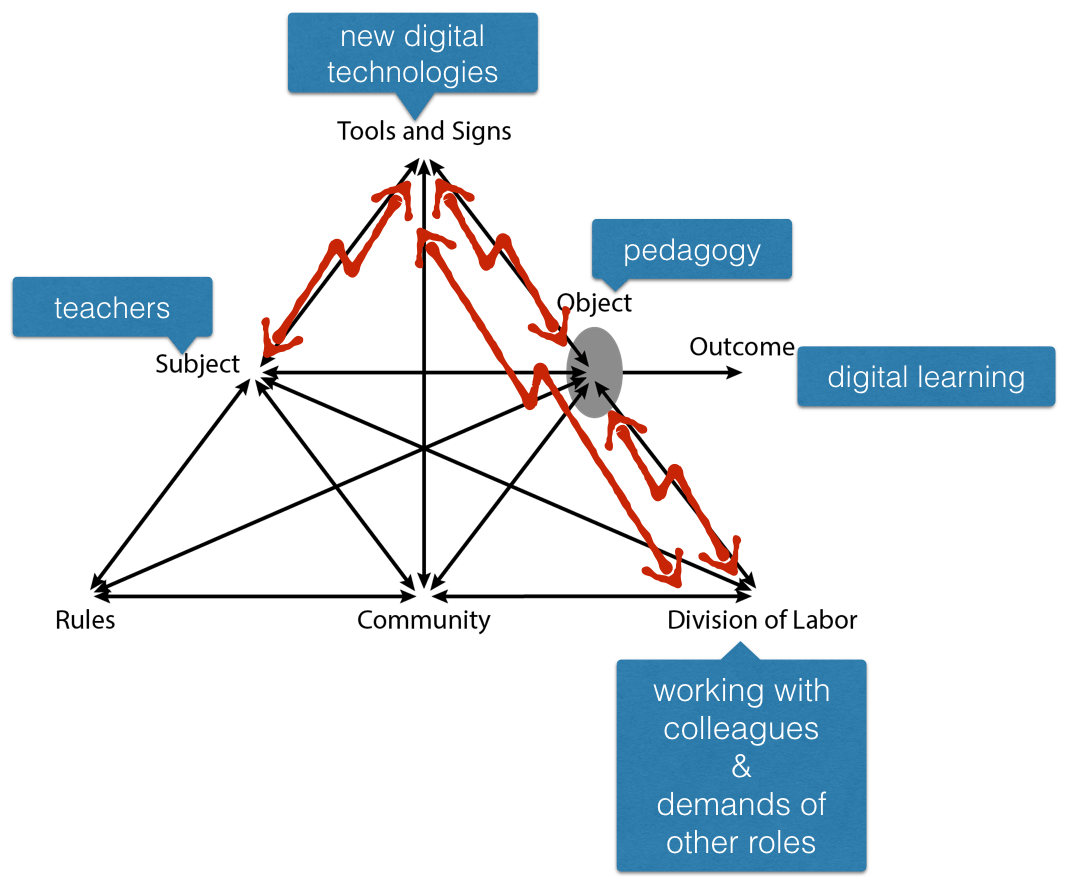
The main contradiction involved inconsistency of pedagogical approach between teachers in subject cohorts with more than one teacher. Specifically, some of the teachers were concerned that using innovative pedagogies in some but not all groups may create inequity. Associated with this were contradictions created when the demands of other roles impacted on the opportunity to collaborate towards innovative approaches.
Teacher-identified contradictions relating to students and parents
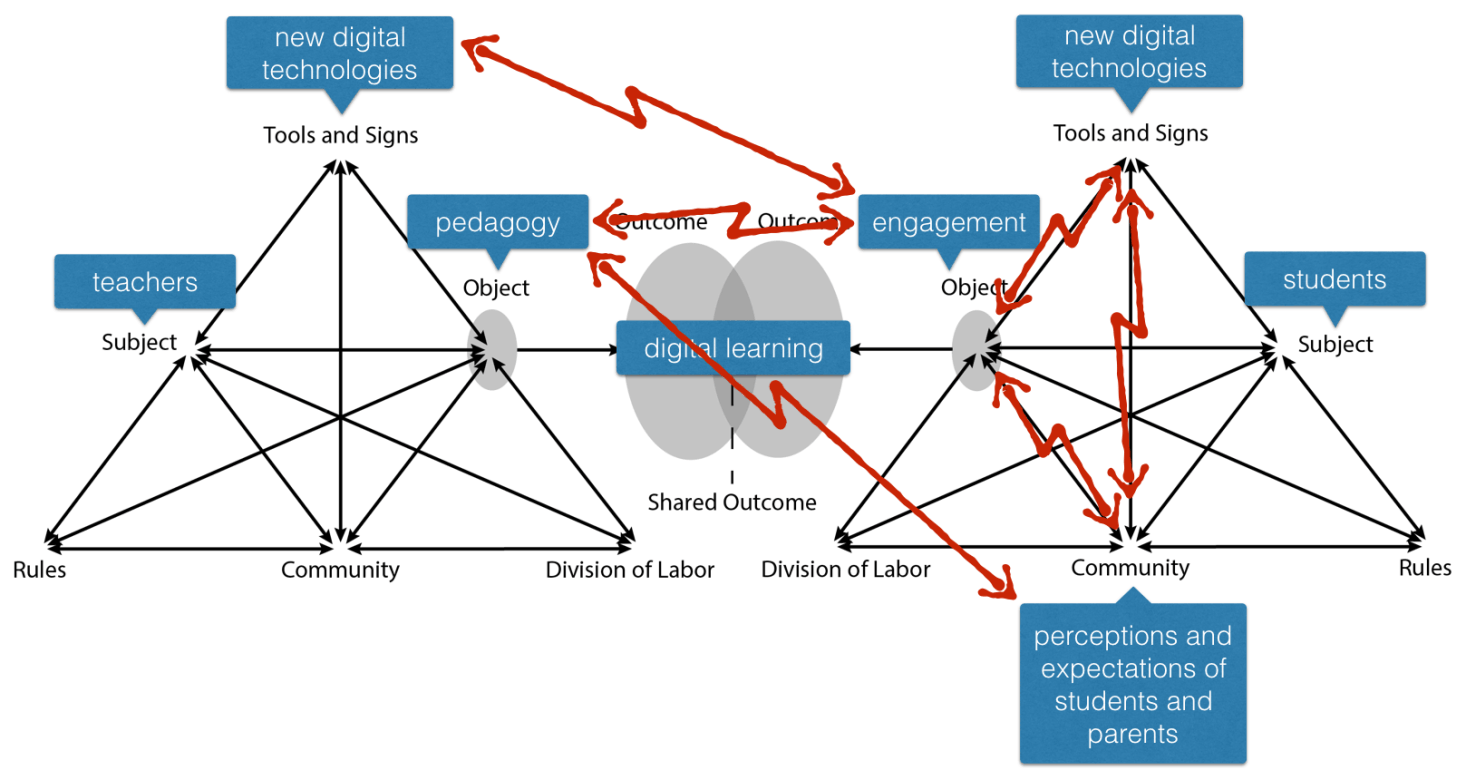
Even within a well-established environment where technology was considered to be a core tool for learning, differences in expectation between teachers, students and parents created contradictions. Much like the previous set of contradictions, there was positive (technology should be used more) and negative (technology should be used less) perceptions; differences created contradictions.
Implications
The findings above were identified when the teachers used Activity Theory (Engeström, 2009) to explore the extrinsic influences on their practice. Through open discussion, the teachers discovered multiple similarities in their experiences, which helped subsequent collaboration. This led to two outcomes. Firstly, through a process of sharing and then collaborative inquiry-based professional learning towards new digital pedagogies, most of the teachers reduced their assessment of the significance of these contradictions (Blundell, Lee, & Nykvist, 2016). Secondly, the teachers found they were able to design digital pedagogies that accommodated contradictions associated with curriculum and assessment as well as perceptions and expectations of students and parents (Blundell, 2017).
For more detail about using theoretical frameworks to conceptualise contradictions, refer to Digital Learning in Schools: Conceptualizing the Challenges and Influences on Teacher Practice (Blundell, Lee, & Nykvist, 2016).